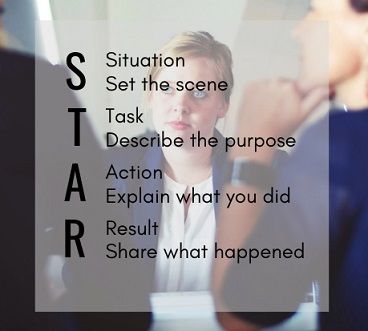STAR interview technique
The STAR interview technique is a way to ensure you answer behavioral-based interview questions effectively. STAR is an acronym to help you remember the method of answering questions in a structured manner. It is especially useful to study this technique if you have an interview in English because it will help you organise your ideas and clarify what you need to explain to your potential employer.
What are behavioral based questions?
Behavioral interview questions ask how you handled certain work situations in the past, so this type of question helps interviewers find out if you have the skills and experiences they are looking for. This type of question usually starts with “Tell me about …” and they ask about a certain competency they are interested in related to the job specification.
Examples of STAR questions:
- Tell me about a time when you had to conform to a policy which you did not agree with.
- Describe to me an experience of how you dealt with a team member who refused to complete his or her portion of the work.
- Give me an example of a time when you had to make a very important decision in a very short amount of time.
What is the STAR interview technique?
 The acronym STAR stands for Situation, Task, Action, Result. If you follow these steps in order you will be able to demonstrate to your potential employer that you have the experience and skills that they are looking for.
The acronym STAR stands for Situation, Task, Action, Result. If you follow these steps in order you will be able to demonstrate to your potential employer that you have the experience and skills that they are looking for.
- S is for Situation: Give the context, some background information in order to set the scene. You should be specific and give details. The situation should be from your professional experience if possible, but if you can think of a good example from a volunteer position or another relevant event it is also valid. Try using business idioms to make your situation seem more relatable to a native English interviewer.
- T is for Task: You should make sure you explain the exact task that you had to complete. It is important you talk about YOU and YOUR role, not the team or the company.
- A is for Action: Highlight what your response was to the task you have described previously. Try to use descriptive action words as you explain your behavior. This is the most important section of your answer, it is your chance to show off your skills and competencies!
- R is for Result: The best type of results are positive results that are can be quantified, or expressed in numbers. It is great if you can explain what you learnt from the situation and if you would do anything differently if you are in the same position in the future.
How can I answer behavioral-based questions using the STAR method?
Follow these four expert tips to ensure success
- Take your time to think about the question and your answer before answering.
- You should spend between two and three minutes answering this type of question.
- Prepare properly before the interview – may be with a native English speaker who has experience in this field.
- Be positive – even though behavioral interview questions sometimes mean you have to focus on a problem or a failure in the workplace, you should remain optimistic. Don’t spend too much time describing the situation in a negative way, skip ahead to the talk about the action you took and the final outcome.
How can I prepare for interviews in English using the STAR interview technique?
Because the STAR interview technique is used by employers to check your competencies and therefore your suitability for the position, you should study the job specification carefully. Be aware of the competencies that the human resources department have specified, and think of examples to illustrate your experience for each one. Make sure your business English vocabulary is up to date, ensure that you feel comfortable completing each of the four stages of the STAR method. Practice answering this type of question beforehand, either by writing down your answers or talking to a friend who is willing to listen.
What should I avoid doing when using the STAR interview technique?
Remember that there are no right or wrong answers to this type of question, but there are some general rules you should bear in mind. Here are three golden rules you should follow.
- Talk about yourself, not your team or your company in general, use “I” not “We” to describe an action that YOU took.
- Be specific – give concrete examples and follow the four steps. Do not use words like ‘in general’.
- Make sure the result of your example was positive – and that you can give quantifiable data to back your story up
Example of STAR method answer to a behavioral interview question
Example question: Give me an example of a time you had to make a difficult decision at work
Example answer:
- S – At the beginning of this year the company I work for was going through financial difficulties.
- T – I was told I had to restructure my team department to fit the new budget, and this would probably involve making people redundant and losing valuable team members. I was very aware that everybody in the department depended on their job as income and I found it a very difficult decision to take.
- A – I consulted with the HR department to help me understand the exact figures behind the restructuring. I led a meeting with the team leaders of the department and explained the situation. I delegated to them the task of interviewing each department member and reporting back at the end of the month. I analysed the data from the interviews and it turned out that they themselves were not very happy with the working situation in terms of hours and schedules etc. I realized that the department consisted of different social groups – such as parents and workers who were studying part-time. The information from the interviews suggested that nearly 30% of the departmental employees were working more hours, including overtime than they wanted to. I again liaised with the HR department and came up with a solution that was acceptable to the majority of the employees.
- R – 30% of the department (5 people) were happy to take a reduction in salary in return for working fewer hours with flexible start and finish times. I had managed to maintain all of the workers, who had received extensive training from the department and it would have been a shame to have lost them. This decision ensured that the new budget was feasible and no one lost their job.








